When the Ku Klux Klan Came to Stanford
California was once ripe for Klan activity. Their organizing at the university and in Palo Alto is part of the country’s long history of racial terrorism.
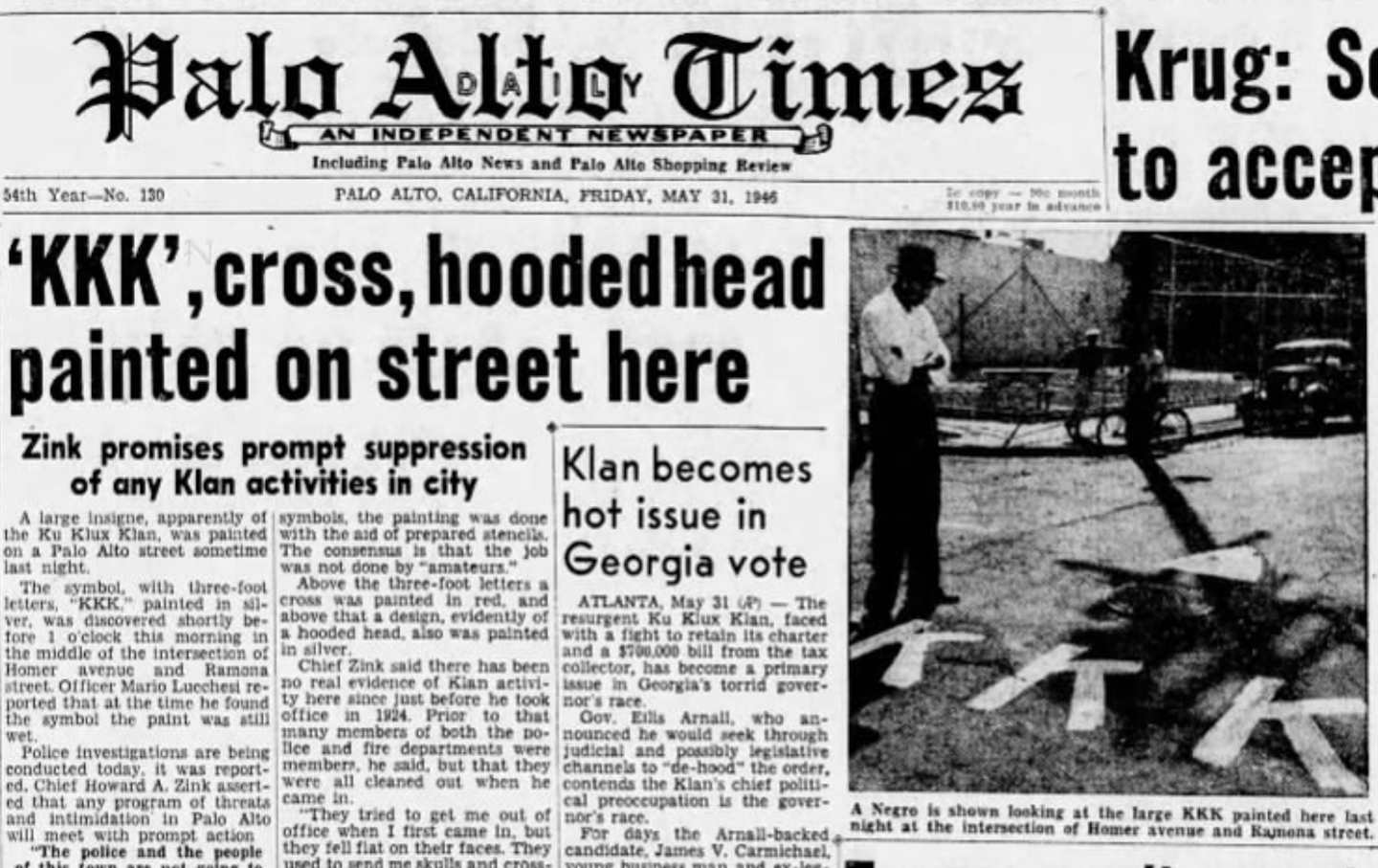
The front page of the Palo Alto Times of May 31, 1946.
“Rumor is abroad on the Stanford campus to the effect that a unit of the Ku Klux Klan is in process of formation here. I desire to set that rumor at rest by confirming it.” So declared Robert Neel Burnett, a graduate student studying civil engineering at Stanford, in a letter published in The Daily Palo Alto in December 1923.
Burnett had gathered about 40 students to start a Klan chapter at the university. The fledgling group faced an uphill battle, receiving opposition from the university’s president and mockery from the student body. But it didn’t halt their growth. “Years ago, Palo Alto, of all places, was teeming with Klandestine goings-on,” read a short testimony in the San Francisco Chronicle article. “In fact, seven Stanford professors reputedly were night-shirters.”
It was the first time the bucolic campus had seen such a commotion. Though the university, founded in 1885 by railroad tycoon Leland Stanford and his, wife Jane, was spearheaded by eugenicists, the Klan had until then spared the sprawling campus for other cities in the Bay Area, most notably Oakland, San Jose, and San Francisco.
When Burnett began organizing the new Klan, national momentum was growing. The 1915 film Birth of a Nation spurred a revival of racist fervor, bringing peak Klan membership up to 4 million by the 1920s. The Golden State, contrary to contemporary perception, was ripe for Klan activity: “California sometimes even held more KKK events than Mississippi or Louisiana,” according to a 2022 state report. “Many of California’s KKK members were prominent individuals who held positions in civil leadership and police departments.” The racial dynamics were material, too, with a largely Chinese and Mexican labor force building the state’s railroads and agricultural sector.
In recent years, universities from the University of Richmond to Brown to the University of Minnesota have made attempts to recognize their ties to slavery or eugenics. In 2020, Stanford renamed a building honoring the university’s first president, David Starr Jordan—a prominent advocate of the eugenics movement—and in 2022 issued a public apology for limiting admissions of Jewish students in the 1950s. While Stanford’s Klan was short-lived, it belongs to a past that is, indeed, national and expansive. And that history is worth confronting.
“I desire now to extend an open invitation to the entire student body, women included, and to the faculty,” Burnett continued in his December 1923 letter to the editor, “to hear an authoritative and unbiased discussion of the Ku Klux Klan.”
Burnett held his first recruitment meeting in the university’s engineering building. This was, by all accounts, unofficial: Burnett never received permission from the head of the department to use the room, who said such a practice “was not customary” and was never informed of the event.
Stanford President Ray Lyman Wilbur made his opposition clear: “It is not my policy to tell students what they may or may not do,” he told The Daily Palo Alto, “but we have the right to say what organizations can use the name of the University.”
Despite his support for eugenics—once expressing fear in a 1926 speech that white women were degenerating because of reliance on dairy milk during nursing—Wilbur barred Burnett’s use of the school’s buildings for Klan purposes, warning that any rebellious enterprise “will find itself in trouble with university authorities.”
Nonetheless, by early January, Burnett had sent pamphlets to students across the campus, seeking to recruit white, Protestant men and women, including members from each fraternity. Among his supplications were an emphasis on “citizenship” and “public schools,” as well as a diatribe against the Catholic church. “If you believe in the public school system of America, get behind the Ku Klux Klan.”
If institutional resistance was a problem for Burnett’s ambitions, his peers’ derision was perhaps a greater one. A response from one of the Daily’s news editors denounced the Klan as “a gang of sheet-knights who go about in disguise after dark and break the law to secure the peace.” But some condemnations came with qualifications: “The fact that…the Klan does good work—although by wrong methods—in one part of the country, and commits fiendish crimes in another part, makes the membership at once suspicious.”
Other writers mocked Burnett’s proposal. “I think your editorial on the Klan last night was entirely un-kalled for,” one letter to the editor began. “There are certainly a lot of things the Klan kan do around here. What about hooding up some night and inducing the authorities to hurry up with that soft drink bar in the Union?”
Popular
“swipe left below to view more authors”Swipe →Burnett’s irritation was evident. “[W]hen the Ku Klux Klan exercises that right, freely conceded all other orders, of banding together certain classes of men for the purposes, among others, of advancing the interests of the WHITE RACE and of Protestantism, you cry ‘prejudice!’” Burnett also accused the university of limiting his freedom of speech. “The Ku Klux Klan has been openly denounced in some of the regular class rooms of this university in the past, and fair play could demand no less than that an opportunity be given for its defense in the same place.”
The official formation of Stanford’s first Ku Klux Klan provoked headlines in the San Francisco Chronicle and the Los Angeles Times. A Daily Palo Alto article reported that at least 30 Stanford men had been initiated in the Klan. Burnett was secretive about the scope of the organization, only saying that it comprised members from nearly every department—though without evidence.
In one sense, the Klan’s presence was not surprising. In 1924, the educational adviser to the Interfraternity Conference said that the Klan was “gaining a rapid foothold in our colleges” nationally. Palo Alto was also in close proximity to San Francisco, which had thriving Jewish and Catholic communities. During the 1920s, the Western Klan was “largely anti-immigrant, largely anti-Catholic, largely anti-Semitic,” said Richard White, professor emeritus of American history at Stanford and author of Who Killed Jane Stanford?
So why—especially given Palo Alto’s history of redlining—were attitudes so unwelcoming toward Burnett?
One answer could be political. “I’m a little surprised there is that much opposition to them in Palo Alto,” White told me. “It could be because California at that time was a largely Republican state, but the Klan was heavily Democratic at the time.”
Malcolm Harris, author of Palo Alto: A History of California, Capitalism, and the World, said that Northern California “didn’t need the Klan because they had the California Highway patrol, which fulfilled the role of the Klan in society.” In any case, “Stanford elites would not have appreciated people harassing their workers.”
“Whether they are vigilante terror groups like the Klan or institutionalized forces like the police, Stanford’s racial violence hides behind bureaucracy and policy that incite harm in order to shirk off the dirty work that it is to maintain white supremacy,” said campus activist and Stanford junior Eva Jones. “These findings perfectly illustrate the institutionalized violence that does the work to impose a racial hierarchy in many Western states.”
Like Wilbur, Stanford’s founding president David Starr Jordan’s affinities for eugenics could coexist with a general dislike of the Klan, which Jordan viewed as a violent and offensive organization. “Racialism was core to Stanford’s identity at this point,” Harris added. “It wasn’t identical with Klanism in the South, but it was extremely racist. And it was definitely white supremacist.”
Burnett, responding to Jordan, seemed well aware of the school’s racial sensitivities. “Many stories of whippings, intimidations, and even of murder commit[t]ed in the name of the Klan have been broadcasted about the country,” Burnett wrote. “With but a single exception, all of these stories have been fully disproved.”
In February 1924, Burnett created a new Klan chapter in Palo Alto, reserved almost exclusively for the city’s businessmen. That same month, Burnett hosted a lecture by James Rush Bronson, one of California’s most prominent Klan lecturers, where Bronson bemoaned the “easy admission” of foreigners and promoted anti-Semitism. “We will not let a member give only 10 cents to the church collection in the morning and pay 55 cents to a Jewish theater owner in the afternoon,” Bronson said.
Bronson called out clergymen and city officials in Palo Alto for refusing to give them a gathering space. “You evidently have a city here which does not believe in the American right to free assembly and freedom of speech.” In March, the Palo Alto Klan held an outdoor initiation ceremony, burning a cross in front of some 500 spectators. Many of them “looked on…curious to identify fellow-citizens shrouded in the soiled linen of bigotry,” one article reported. Later that year, 15 vehicles carried robed Klansmen in a “parade” through the city’s business district.
Expansion was a clear objective. “With a unit formed on the Stanford campus and another in the city of Palo Alto,” wrote the Daily Palo Alto Times, “the klan is quite astride our community.” Though Klan groups are historically noted for their emphasis on white Protestant male identity, women’s chapters were also common nationwide, first emerging in the 1860s. By May, Burnett had founded a women’s branch that boasted over 50 members at its height.
In Palo Alto, as in Stanford, local condemnation was swift. An editorial made the city’s position clear: that “there is no place in the American order of things for an organization that is founded on racial hatred and religious intolerance.”
The Klansmen, who were refused by churches and the city hall, found it difficult to organize around the city. The owner of a meeting hall barred the Klan for fear of a loss of Catholic customers. A San Francisco Chronicle article reported that Palo Alto Police Chief Chester Noble had ousted several alleged Klansmen from the police departments and claimed that the fire department “was honeycombed with Klansmen.”
In Palo Alto, the Klan’s chapters would soon be no more, at least for the meantime. A San Francisco Chronicle article reported that after much pressure, police forces eventually broke into a secret Klan meeting and beat up the discreet members. After that, the Klan departed for Oakland.
In 1946, the Klan would resurface once more in Palo Alto. “It is something that seems to happen after every war,” said the city’s police chief. At a street intersection, a large KKK insignia was painted in the middle of the night, along with a cross and hooded head. The police promised prompt suppression of Klan activities, certain that it wasn’t the work of “children” or “pranksters.” Officials decided to leave the insignia for a while “so that people can see it and form their opinions.”
“Do you think I should take my sister and her four children and leave?” a Black veteran reportedly asked. Later that winter, a woman working for one of the city’s anti-housing discrimination groups was warned in letters by self-proclaimed Klansmen to not help a Black 22-year-old whose house near Redwood City was burned in an act of racist terrorism. Two years later, a cross was burned in front of a Palo Alto home owned by Jews, who “saw the glow” and “kicked the Ku Klux Klan symbol into the gutter.”
The police chief feared a “new outbreak of Klan intolerance,” and the community reconvened to squeeze out whatever Klan presence had remained in—or reentered—the city. After a last report of “anti-Negro incidents” in 1951, the respectable, progressive-faced Palo Alto seemed to revert back to form: no further Klan activity was reported in the area. In December 2007, Matt Bowling, a historian and former Palo Alto resident, wrote an article for the Palo Alto Daily News titled “The Ku Klux Klan comes to Palo Alto.” It was one of the first efforts to acknowledge the city’s KKK history. “I had no idea before I started looking into it that the KKK had gained some following in Palo Alto.” For Bowing, the Klan’s presence was “a small blip where perhaps a few locals flirted with the ideas of the KKK,” but the city’s historic use of redlining “was much more pervasive and in the end, more harmful to people of color.”
The Klan wouldn’t return to Stanford after Burnett’s departure, but prejudice has not been absent from campus life. Dick Block, who earned a bachelor’s degree from Stanford in 1949, recalls a virulently anti-Semitic fraternity system. “I didn’t really pay attention to the race of anybody, but I think all my teachers were white,” Block told me. He remembers one Black student and a small number of Asian students. “I mean, it was totally white.” The university is known to have limited Jewish enrollment in the 1950s.
Though Stanford’s first Black student, Ernest Houston Johnson, graduated in 1895, the university did not see more than a handful of Black students until the early to mid-1960s. In 2017, Stanford Magazine published interviews with seven Black members of the freshman class of 1962, revealing a world of alienation and racism. In some ways, this legacy continues to reverberate in recent university polls, which show that nearly two-thirds of Black students have faced at least one racial microaggression on campus.
Today, when many (if not a majority) of residential and dining workers on campus are Black and Hispanic, systemic racism now burdens more groups. In April 2020, the university made a commitment to extend pay for laid-off janitorial workers, only to leave dozens without pay later that fall. Earlier this year, labor disputes erupted anew after Stanford switched to a new custodial subcontractor, placing 25 janitorial workers at risk of losing their jobs.
“The institution, realistically, is [never] going to do anything without feeling some kind of external pressure,” Kyle Wang, a union representative in San Francisco and recent Stanford graduate, told me. “We often forget when we’re at a university like Stanford that its power depends on the labor of hundreds, if not thousands, of people. And those people have a lot more power than they think. The more concrete thing for me is always: How can students organize?”
Uncovering Burnett’s legacy might mean returning to the darker aspects of Stanford—and California—history. “Palo Alto has a certain veneer or self conception as a liberal utopia,” Michael Hines, an assistant professor and historian of American education at Stanford, told me. But the racial past is “a needed history, and it’s something that needs to be grappled with.”
Ben Maldonado, a recent Stanford graduate pursuing a PhD in history at Harvard University, is the founder of the Stanford Eugenics History Project, which in 2020 helped push the university to rename buildings honoring eugenicists—including David Starr Jordan. “Sometimes the KKK gets presented as a group of villainous Southerners ostracized in popular society reacting violently to changing norms,” Maldonado said. Burnett’s failed venture is “a good example” that the Klan was not confined to its Southern stereotype.
Much of previous discourse at Stanford has focused on Jordan, encouraging an often unproductive treatment of historical events “as independent points in time,” according to Maldonado. The knowledge of the KKK at Stanford and in Palo Alto invites an opportunity to confront “a long history” of racial terrorism not just at the university, but across the country.
“The university has welcomed the opportunity to reckon with aspects of its history including the recent creation of a Jewish Admissions Task Force and report on its findings, and the renaming of university buildings, streets, monuments, endowed positions, and prizes, when there is strong evidence that retaining the name is inconsistent with the university’s integrity or is harmful to its research and teaching missions and inclusiveness,” wrote Stanford University spokesperson Stett Holbrook in a statement to The Nation. “Because the effort to organize the KKK on our campus was extremely brief, never endorsed or otherwise recognized by the university, and was swiftly denounced by President Wilbur we have not elected to further recognize this reprehensible organizing effort.”
Marne Campbell, the chair of African American studies at Loyola Marymount University, points to her own institution as presenting an example of a way universities might begin to address their history. They “have to be willing to admit that there’s something in their past that has contributed to widening the gap between white people and people of color,” Campbell said. “Our history in California, though it’s different from what we think of in the South, at the end of the day a lot of it is the same.”
Disobey authoritarians, support The Nation
Over the past year you’ve read Nation writers like Elie Mystal, Kaveh Akbar, John Nichols, Joan Walsh, Bryce Covert, Dave Zirin, Jeet Heer, Michael T. Klare, Katha Pollitt, Amy Littlefield, Gregg Gonsalves, and Sasha Abramsky take on the Trump family’s corruption, set the record straight about Robert F. Kennedy Jr.’s catastrophic Make America Healthy Again movement, survey the fallout and human cost of the DOGE wrecking ball, anticipate the Supreme Court’s dangerous antidemocratic rulings, and amplify successful tactics of resistance on the streets and in Congress.
We publish these stories because when members of our communities are being abducted, household debt is climbing, and AI data centers are causing water and electricity shortages, we have a duty as journalists to do all we can to inform the public.
In 2026, our aim is to do more than ever before—but we need your support to make that happen.
Through December 31, a generous donor will match all donations up to $75,000. That means that your contribution will be doubled, dollar for dollar. If we hit the full match, we’ll be starting 2026 with $150,000 to invest in the stories that impact real people’s lives—the kinds of stories that billionaire-owned, corporate-backed outlets aren’t covering.
With your support, our team will publish major stories that the president and his allies won’t want you to read. We’ll cover the emerging military-tech industrial complex and matters of war, peace, and surveillance, as well as the affordability crisis, hunger, housing, healthcare, the environment, attacks on reproductive rights, and much more. At the same time, we’ll imagine alternatives to Trumpian rule and uplift efforts to create a better world, here and now.
While your gift has twice the impact, I’m asking you to support The Nation with a donation today. You’ll empower the journalists, editors, and fact-checkers best equipped to hold this authoritarian administration to account.
I hope you won’t miss this moment—donate to The Nation today.
Onward,
Katrina vanden Heuvel
Editor and publisher, The Nation
More from The Nation
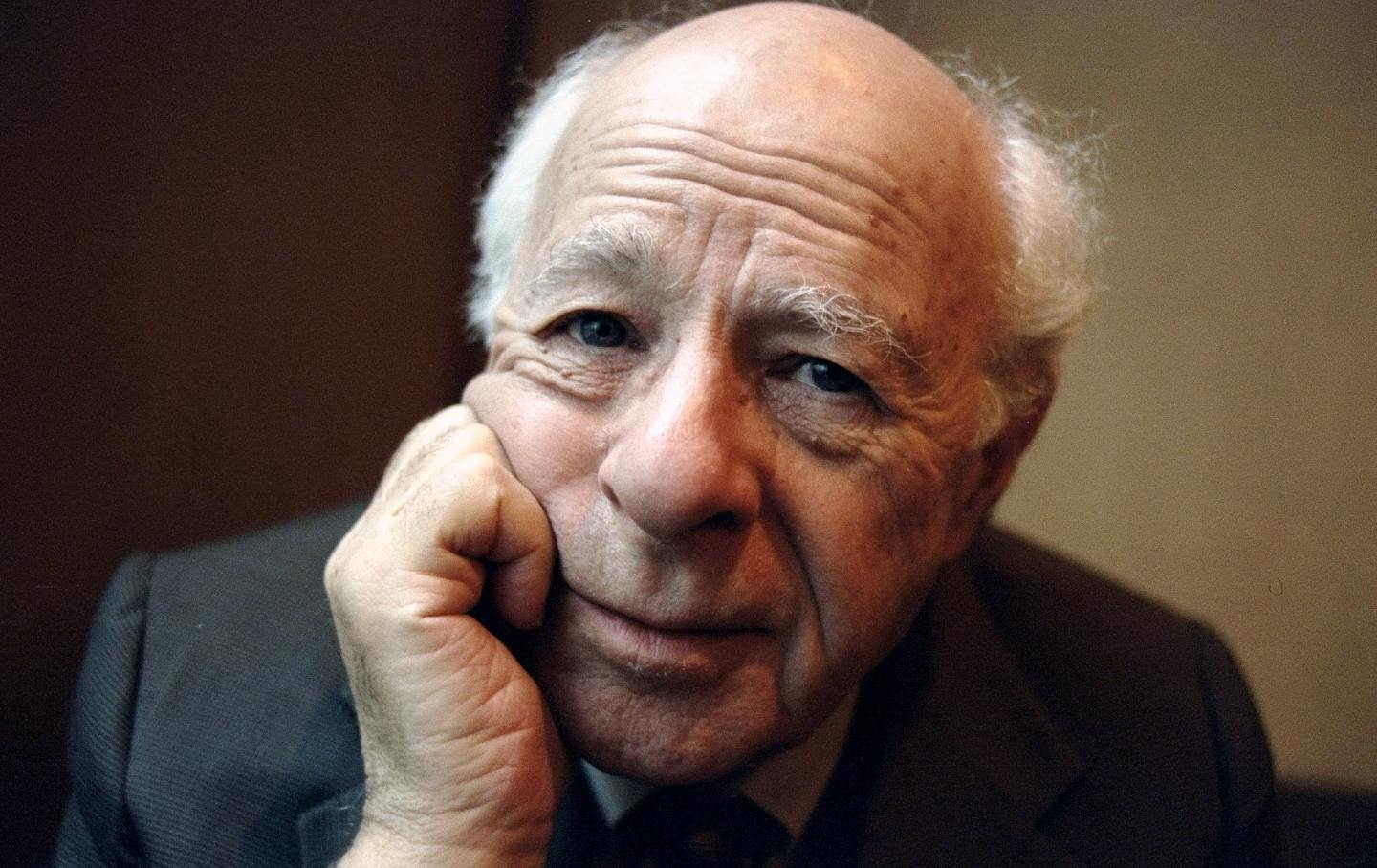
The Longest Journey Is Over The Longest Journey Is Over
With the death of Norman Podhoretz at 95, the transition from New York’s intellectual golden age to the age of grievance and provocation is complete.
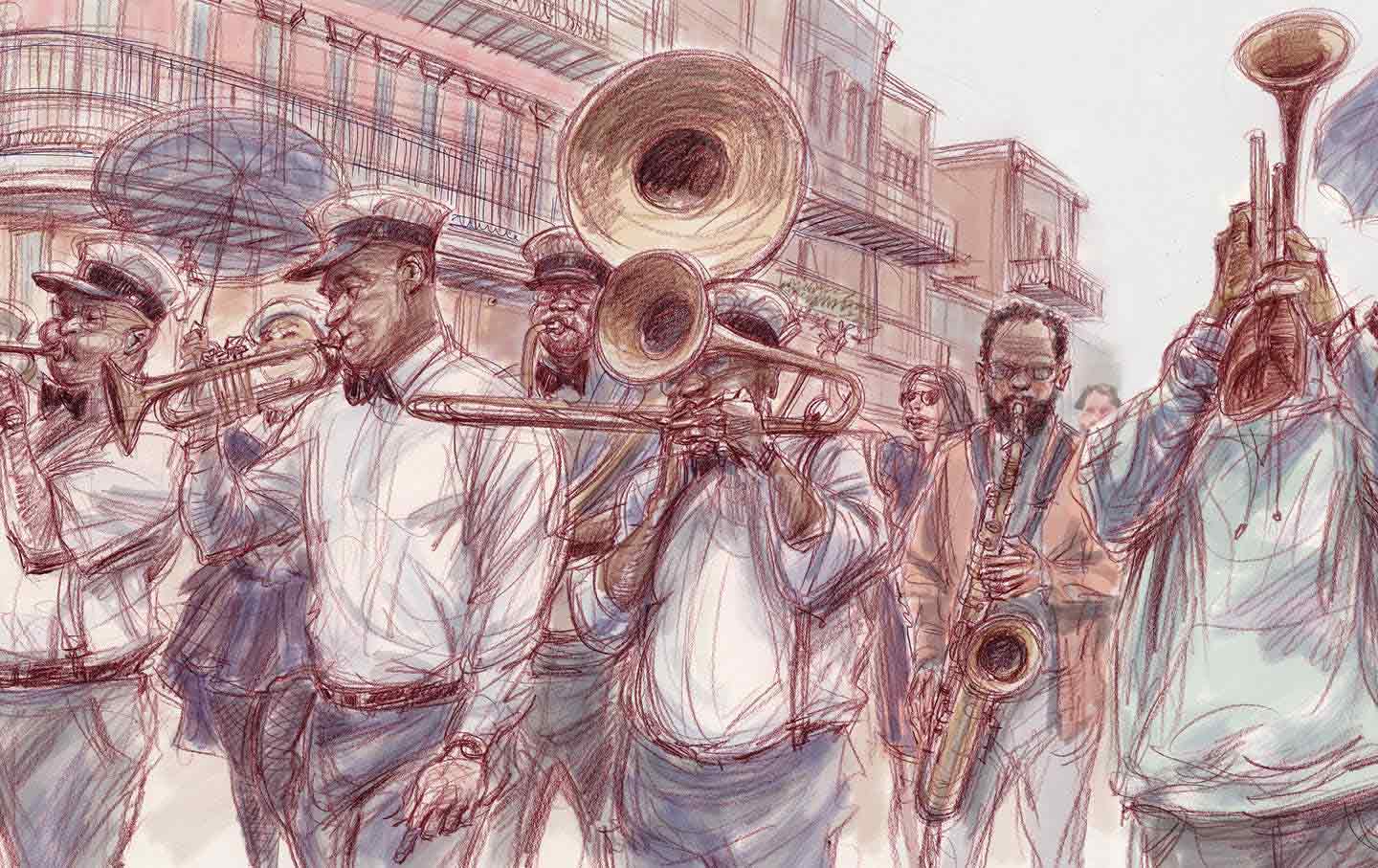
The Fight to Keep New Orleans From Becoming “Everywhere Else” The Fight to Keep New Orleans From Becoming “Everywhere Else”
Twenty years after Katrina, the cultural workers who kept New Orleans alive are demanding not to be pushed aside.

Breaking the LAPD’s Choke Hold Breaking the LAPD’s Choke Hold
How the late-20th-century battles over race and policing in Los Angeles foreshadowed the Trump era.
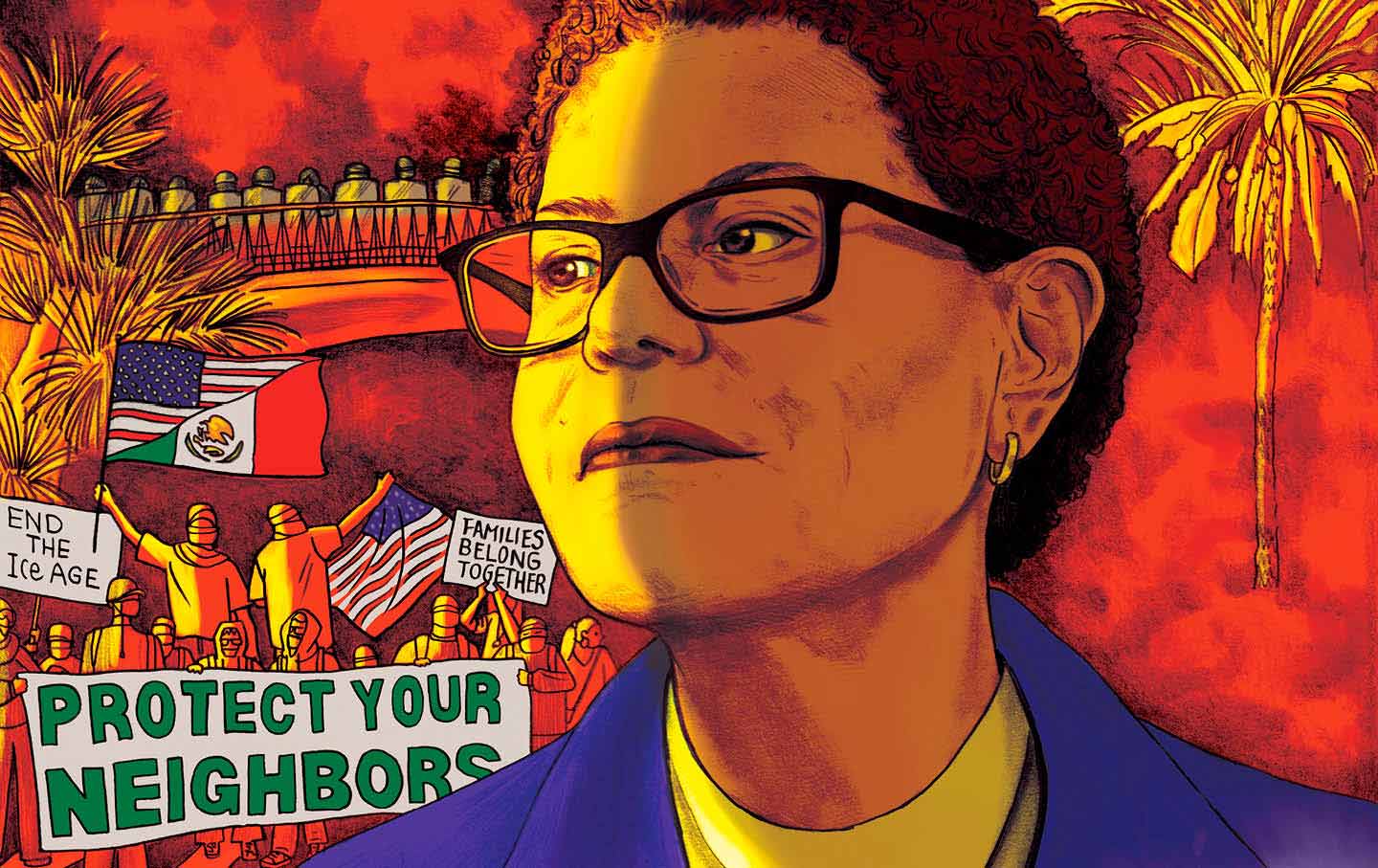
Mayor of LA to America: “Beware!” Mayor of LA to America: “Beware!”
Trump has made Los Angeles a testing ground for military intervention on our streets. Mayor Karen Bass says her city has become an example for how to fight back.
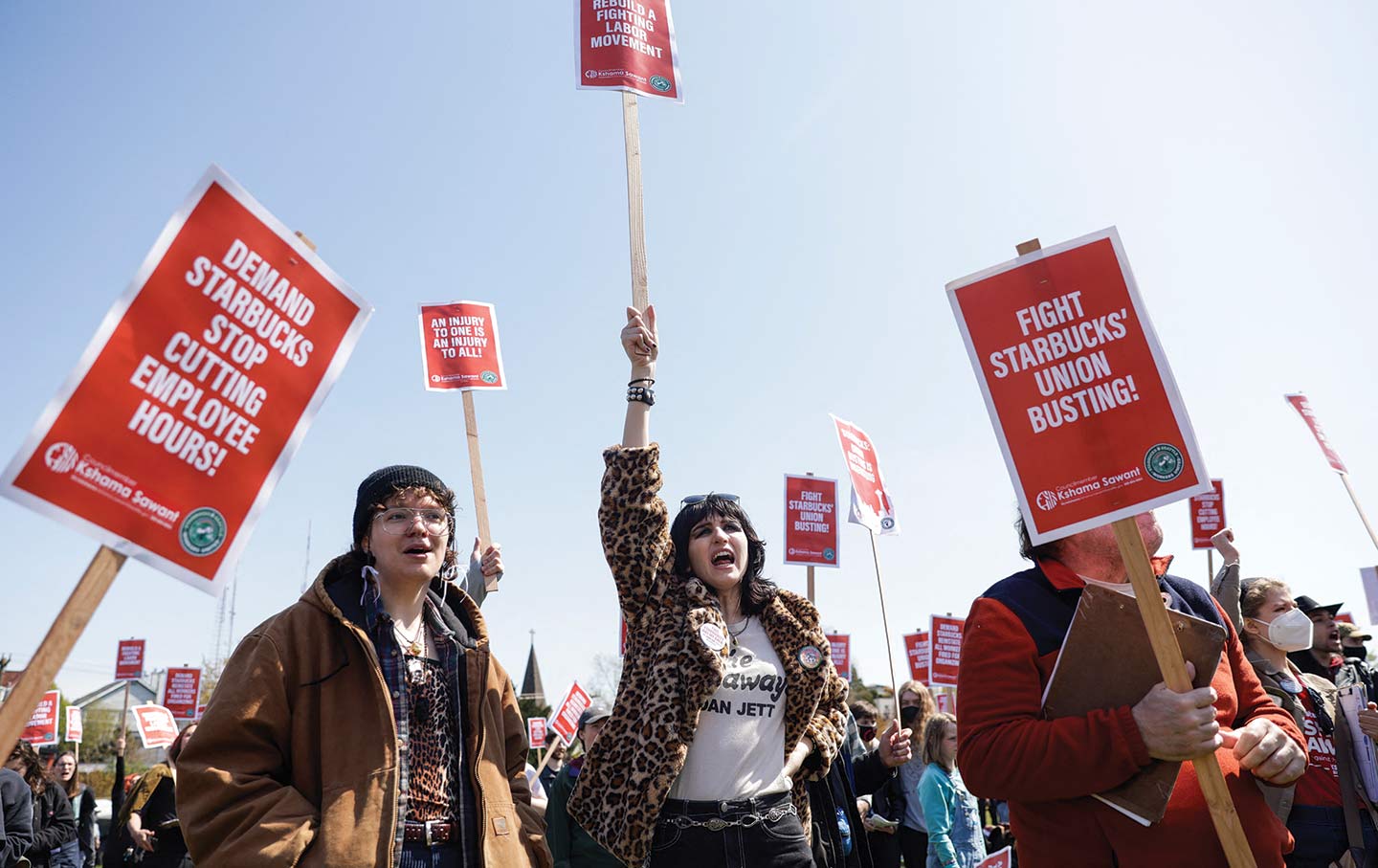
Organized Labor at a Crossroads Organized Labor at a Crossroads
How can unions adapt to a new landscape of work?
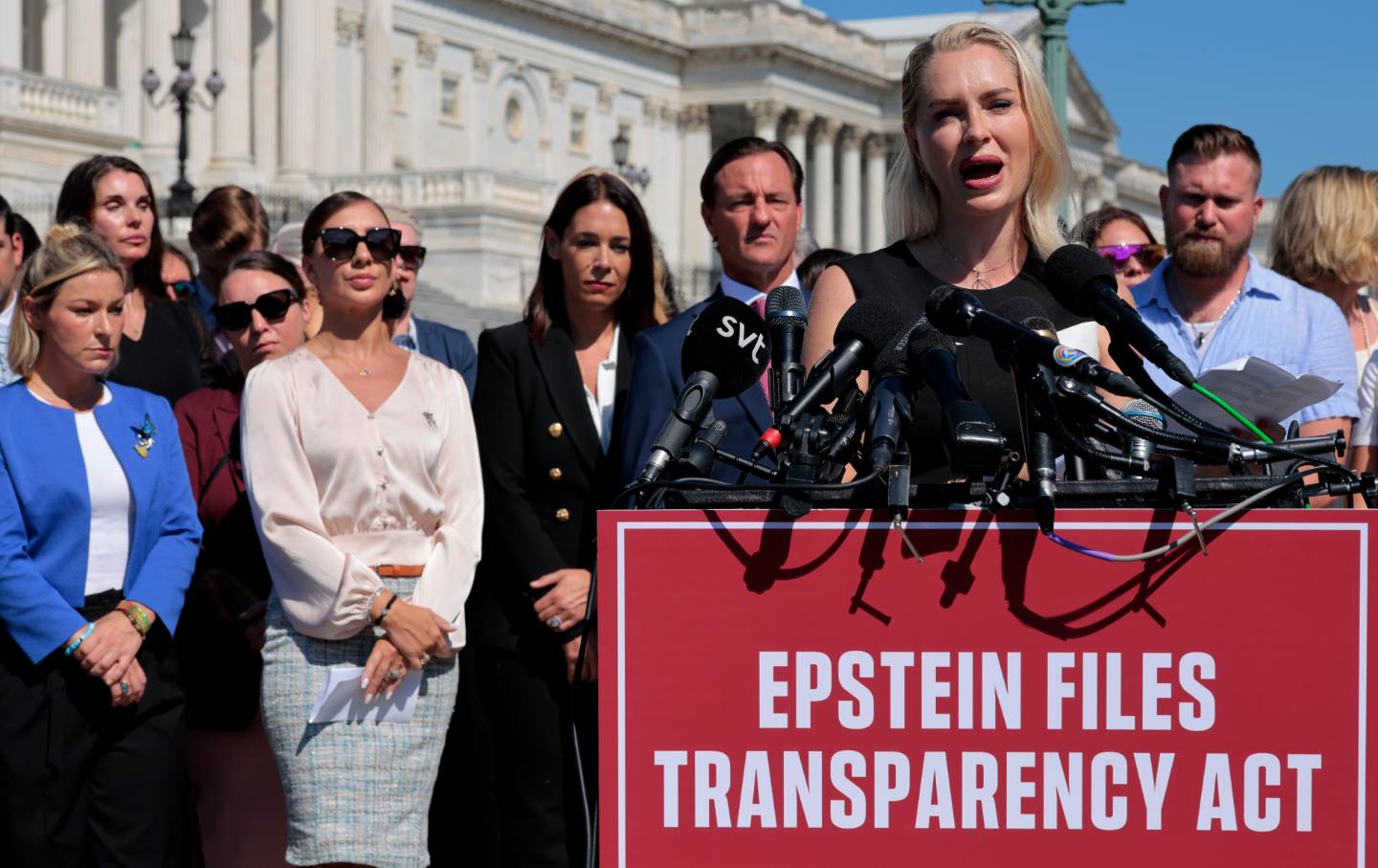
The Epstein Survivors Are Demanding Accountability Now The Epstein Survivors Are Demanding Accountability Now
The passage of the Epstein Files Transparency Act is a big step—but its champions are keeping the pressure on.


